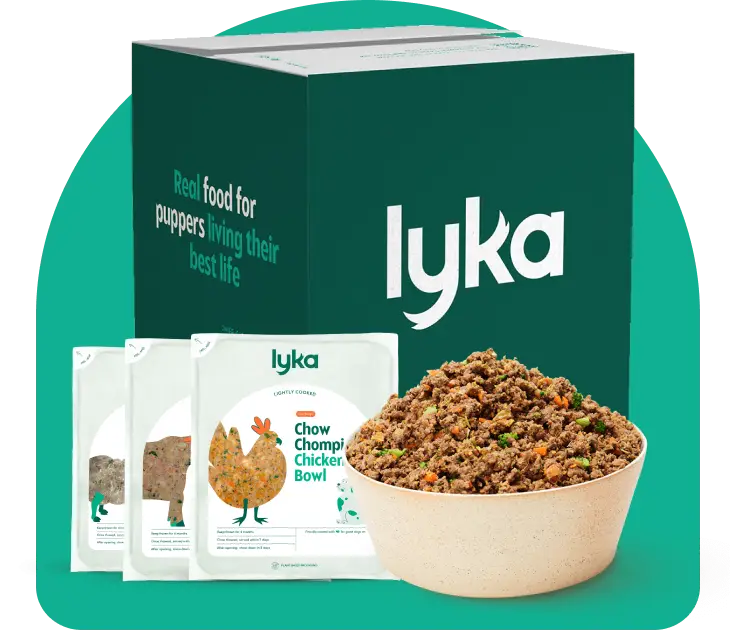If you feel completely overwhelmed by the choices of dog food options piled high down each pet shop aisle, you’re not alone.
When it comes to kibble, all food pellets tend to look the same no matter the brand, and the ingredient lists can seem like another language.
What is the difference between “with chicken”, “chicken meal”, “chicken digest” and “chicken by-products”? Are they the same? It’s very confusing.
We know you want the best for your fur baby and choosing the right food is important. To help you understand the confusing world of dog food ingredients, we’ve created a glossary of some common terms you might see on the packaging.
The unregulated Australian pet food industry
Before we look at the language of labels, there’s one really important fact you need to know — the Australian pet-food industry is largely unregulated.
Australian-made pet food isn’t necessarily made to a higher standard than other imported products, which seems very un-Australian to us. Although there are standards that manufacturers have to abide by, they’re voluntary, making the whole Aussie pet food industry self-regulated.
Barking mad, we know!
Look for brands that state that they meet AAFCO (Association of American Feed Control Officials) standards. The AAFCO establishes guidelines for pet food manufacturers, including ingredient definitions and lists, nutritional analysis and labelling. Although the AAFCO isn’t a regulatory body, pet food brands employ third parties to test their products against these guidelines.
Many good Australian (and New Zealand) pet food manufacturers will state that they comply with the AAFCO Dog Food Nutrient Profiles to give their customers some reassurance of quality.
Learning the language of labels
When checking the ingredients list on the back of the package, remember that they’re structured from most to least in terms of content.
You might also find a guaranteed analysis section, which is a percentage breakdown of the minimum amounts of particular ingredients. These details should give you a clearer picture of what the dog food is made from.
1. “Premium”, “Super Premium” or “Gourmet”
You’d be forgiven for thinking that food labelled as “premium” would be required to meet a higher standard to deserve such an accolade. Sadly not. There is no hierarchy of standards in the pet food industry.
Brands might use this type of language to indicate their ingredients are superior to other brands, but you’d have to compare the listed ingredients to establish this. Otherwise, it’s just very effective marketing.
2. “…with chicken”
To be labelled “…with chicken” means there must be a 3% minimum chicken content. The same principle applies to any food labelled “with \[an ingredient\]”.
3. Meat by-product
Meat by-products are the animal remains after the parts for human consumption have been removed. It usually includes 4D meats like organs, bones and fatty tissue.
Selected meat by-products, like liver and kidneys, can be nutritious for your pup, but too much fat can be detrimental to their health.
4. Animal fat
Dogs need fat to survive. But, as we know, not all fats are the same — there are good fats and bad fats.
If the list states “animal fat”, this is usually the fat that’s produced from the rendering process that creates meat meal. There’s no identification of the type of fat, so the quality is most likely poor. Many dry food manufacturers use “animal fat” as a cheap filler and to boost the palatability of cheap, processed ingredients.
The inclusion of specific animal fats like omega-3, flaxseed oil, chicken fat or fish oil, clearly demonstrates their origin and indicates their quality as a purposeful nutrient addition.
5. Wheat
Wheat is a widely cultivated grain used in many human and animal foods because it’s a cheap and accessible product.
It’s always worth identifying the position of “wheat” in the ingredients, or the percentage content, as too many carbohydrates are unhealthy for your pup. Plus, not all dogs can tolerate wheat gluten, which can trigger a food sensitivity.
Even if your dog isn’t gluten-intolerant, you might be tempted to purchase gluten-free or grain-free food thinking it will be a healthier option. Check which ingredients have replaced the wheat (or other gluten), as some brands simply use other fillers like pea protein and beet pulp, which aren’t a better choice and can lead to other health issues.
6. Beet pulp
This ingredient is the cheap by-product of sugar beet, not macerated beetroot.
Once the sugar has been extracted from the beet, all that remains is a very fibrous pulp. It is often used as horse fodder or as dog food filler. Research indicates that beet pulp can impair digestion rather than aid it.
Instead of beet pulp, we suggest looking for fibre-rich wholefood ingredients like butternut squash, carrots or purple sweet potatoes.
7. Cereal by-products
These are the products leftover from processing the grain, including bran and germ. Cereal by-products can have nutritional value when used in the right proportions, but they’re often used as a cheap filler.
8. Vegetables and fruit
Vegetables and fruit are fantastic sources of vitamins, minerals and fibre. Added in the right quantities, they can contribute to a complete and balanced diet.
Kibble undergoes extremely high cooking temperatures to achieve a biscuit-like consistency. This means that the nutritional value of any fresh vegetables is usually lost in the process.
Watch out for ingredients like apple pomace or tomato pomace. They might sound healthy, but like beet pulp, pomace is the fibrous by-product from juicing the fruit and does not have the same nutritional value as the whole fruit.
9. Yucca extract (Yucca Schidigera Extract)
Often small amounts of yucca extract are added to dog food recipes for its ability to reduce faecal odour.
Yucca extract contains saponins which create foam when in contact with water. This can improve the digestive tract in the dog’s system, but too much can cause irritation and potentially be toxic.
Not to be confused with Yuca (Cassava), an entirely different plant.
10. Corn syrup
Known as glucose syrup in Australia, corn syrup is made from corn starch. Its high sugar content is not suitable for dogs.
Manufacturers add this unhealthy ingredient to dog food as a preservative and to soften the texture of the product. It’s also used to improve palatability. It might taste good to your pup, but it’s not good food.
11. Propylene glycol
Propylene glycol is a chemical additive that absorbs water. It’s used in some semi-moist dog foods to maintain its soft texture.
It’s also used in anti-freeze and dry ice. We kid you not.
It can cause allergic dermatitis and Heinz body formation, a type of anaemia.
12. Palatant
Dog food palatants are additives that make the food seem tasty. They’re often sprayed onto the kibble pellets to appeal to your pup’s sense of smell that stimulates their appetite.
Dry food brands often use palatants because the low meat content and high cooking temperatures make the kibble relatively tasteless and unappetising.
Look out for ingredients like “Chicken Digest” on the packaging. This is an animal protein (often a by-product) that has been artificially “digested” by enzymes or acid to form a spray or powder used to coat kibble.
13. MSG (Monosodium Glutamate)
MSG is a common flavour enhancer used in both dog and human food. The packaging might not label the ingredient as MSG or Monosodium Glutamate. Instead, you might find “flavour enhancer 621” or “E621”.
Although the additive is GRAS (generally regarded as safe), it can be toxic to dogs, potentially causing digestive problems or seizures.
14. BHA and BHT
BHA (Butylated Hydroxyanisole) and BHT (Butylated Hydroxytoluene) are chemical additives used to preserve the fat content and extend the shelf life of the product. BHA and BHT are also used in cosmetics, rubber and petroleum products.
Although these synthetic antioxidants are often added to human and pet food, they’re not harmless. They can cause lung damage and are proven to be carcinogenic in animals.
15. Sodium Nitrate or Nitrates
These chemical compounds are preservatives widely used in processed meat, like salami, bacon and hot dogs, and dog food. They also create an “appetising” meaty colour for the benefit of us humans, not our pups. Excessive amounts of sodium nitrate in the diet can cause cancer.
Although sodium nitrate is used widely in human food, most people eat a varied diet and don’t consume processed meat two to three times a day. But our pups tend to eat the same food creating a cumulative effect and increasing their risk of cancer.
16. x gum, x germ, x protein, x flour, x starch, x fibre, x gluten
You might notice some ingredients like:
Guar gum
Wheatgerm
Pea protein
Rice flour
Potato starch
Oat fibre
Wheat gluten
These are common thickeners or cheap fillers used to create the texture of kibble.
Some manufacturers have chosen to remove the gluten from their recipes so they’re “grain-free” and “gluten-free”. Instead of gluten, they may use peas as a cheap filler.
If the food uses a lot of cheap pea-based filler, this can lead to a compound effect of excess purine and uric acid. Unfortunately, this can trigger a lot of flatulence, upset stomachs, and other health issues.
You also might notice what’s known as “ingredient splitting”. A label might indicate that most of the food is made from meat, but if you add up the pea protein, pea flour, and pea fibre, the pea content outweighs the meat content. Sneaky, huh!
The Lyka difference — real food you can see
At Lyka, our 100% human-grade meals are bursting with drool-worthy fresh ingredients. We even test the dishes ourselves. Because if we won’t eat it, we won’t serve it!
Each dish is lightly cooked and then snap-frozen to lock in the taste and nutrition, and minimise pathogens and bacteria. We don’t use artificial flavours, preservatives, additives or enhancers and we steer clear of nasty fillers and palatants.
A complete and balanced diet is the foundation of good health. We’re always transparent when it comes to our ingredients because we want you to know exactly what’s in your dog’s food.
Dog food should be real food. That’s it.
Learn more about our fresh food philosophy and what makes us different.
)
)
)
)
)

)
)
)
)
